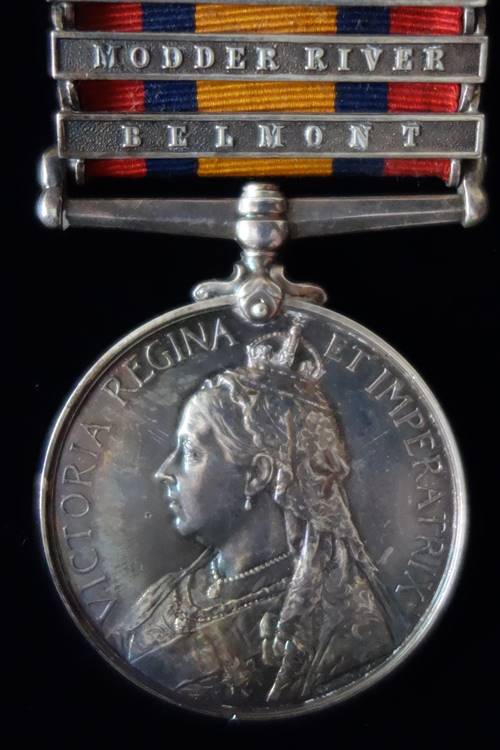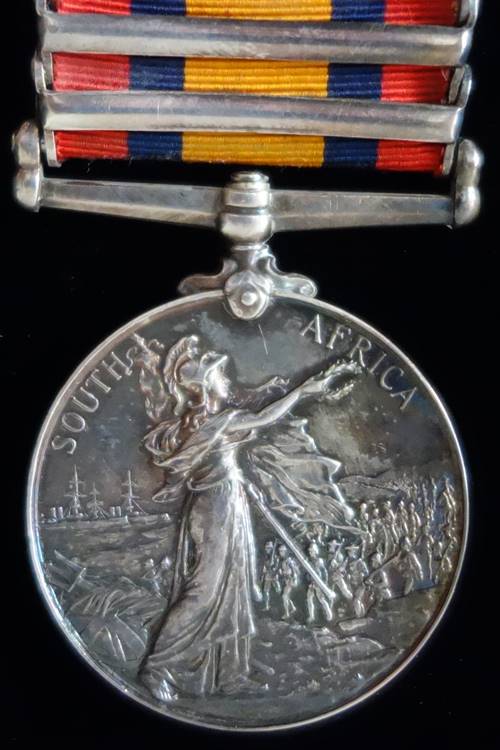This article looks at the Queen’s South Africa Medal which is often encountered in First World War medal groups. I have also written articles on the King’ South Africa Medal, First World War medals and how to research those who served in the British Army:
The Queen’s South Africa Medal
How a Soldier Qualified for the Queen’s South Africa Medal
The following extract is taken from Army Order No.94 of 1901 which describes how a soldier qualified for the Queen’s South Africa Medal. In essence, they had to serve in South Africa between 11 October 1899 and 31 May 1902:
The medal, in silver, will, provided the claims are approved by the Commander-in-Chief, be granted to all officers, warrant officers, non-commissioned officers and men of the British, Indian and Colonial Forces, and to all nurses and nursing sisters, who actually served in South Africa between 11th October, 1899, and a date to be hereafter fixed; and to troops stationed in St. Helena between the 14th April, 1900, and a date to be hereafter fixed.
Queen’s South Africa Medal Clasps
In total, there were twenty-six clasps which could be awarded for the Queen’s South Africa Medal and the award criteria apart from the South Africa 1901 and 1902 clasps was transcribed from Army Order No.94 of 1901. The Queen’s South Africa Medal was also awarded with no clasps.
Belfast: Granted to all troops who, on 26th or 27th August 1900 were east of a north and south line drawn through Wonderfontein (the garrison and troops quartered at Wonderfontein on those dates will not receive this clasp), and west of a north and south line through Dalmanutha Station, and north of an east and west line through Carolina.
Belmont: Granted to all troops under Lieut-General Lord Methuen’s command who were north of Witteputs (exclusive) on 23rd November 1899.
Cape Colony: Granted to all troops in Cape Colony at any time between 11th October 1899, and 31st May 1902, inclusive, who had not received a clasp for a specific action in Cape Colony nor the “Natal” clasp.
Defence of Kimberley: Granted to all troops in the garrison of Kimberley between 14th October 1899, and 15th February 1900, both dates inclusive.
Defence of Ladysmith: Granted to all troops in Ladysmith between 3rd November 1899, and 28th February 1900, both dates inclusive.
Defence of Mafeking: Granted to all troops in the garrison of Mafeking between 13th October 1899, and 17th May 1900, both days inclusive.
Diamond Hill: Granted to all troops who, on 11th or 12th June 1900, were east of a north and south line drawn through Silverton Siding and north of an east and west line through Vlakfontein.
Driefontein: Granted to all troops with Army Headquarters, and Lieut.-General French’s column, i.e., the left and centre columns, which advanced from Poplar Grove on 10th March 1900.
Elandslaagte: Granted to all troops at Elandslaagte on 21st October 1899, who were on the right bank of the Sunday river and north of an east and west line through Buys Farm.
Johannesburg: Granted to all troops who on 29 May 1900 were north of an east and west line through Klip River Station (exclusive) and east of a north and south line through Krugersdorp Station (inclusive).
Laing’s Nek: Granted to all troops of the Natal Field Force employed in the operations, and north of an east and west line through Newcastle between the 2nd and 9th June 1900, both dates inclusive.
Modder River: Granted to all troops under Lieut-General Lord Methuen’s command who were north of Honey Nest Kloof (exclusive), and south of the Magersfontein ridge (exclusive) on 28th November 1899.
Orange Free State: Granted to all troops in Orange River Colony at any time between 28th February 1900, and 31 May 1902, inclusive who had not received a clasp for a specific action in the Orange River Colony.
Paardeberg: Granted to all troops within 7,000 yards of General Cronje’s final laager, between midnight of the 17th and midnight of the 26th February 1900, and to all troops within 7,000 yards of Koodoe’s Rand Drift between those dates.
Relief of Kimberley: Granted to all troops in the relief column under Lieut-General French who marched from Klip Drift on 15th February 1900, and all the 6th Division, under Lieut.-General Kelly-Kenny who were within 7,000 yards of Klip Drift on 15th February 1900.
Relief of Ladysmith: Granted to all troops in Natal north of and including Estcourt between 15th December 1899, and 28th February 1900, both dates inclusive.
Relief of Mafeking: Granted to all troops under the command of Colonel Mahon who marched from Barkly West on 4th May 1900, and to all troops who were under Colonel Plumer’s command between 11th October 1899, and 17th May 1900, both dates inclusive, and who were south of an east and west line drawn through Palachwe.
Rhodesia: Granted to all troops who were under the command of Lieut.-General Sir F. Carrington and Colonel Plumer in Rhodesia, between 11th October 1899, and 17th May 1900, both dates inclusive, or who landed at Beira between 11th October 1899, and 25th May 1900, both dates inclusive.
South Africa 1901: Granted to troops who served in South Africa between 1 January and 31 December 1901 and weren’t eligible for the King’s South Africa Medal.
South Africa 1902: Granted to troops who served in South Africa between 1 January and 31 December 1902 and weren’t eligible for the King’s South Africa Medal.
Talana: Granted to all troops under Lieut-General Sir W. Penn Symons’ command on 29th October 1899, who were north of an east and west line drawn through Waschbank Station.
Transvaal: Granted to all troops in the Transvaal at any time between 24th May 1900, and 15th 31 May 1902 inclusive who received no clasp for a specific action in the Transvaal.
Tugela Heights: Granted to all troops of the Natal Field Force, exclusive of the Ladysmith garrison, employed in the operations north of an east and west line through Chieveley Station between the 14th and 27th February 1900, both dates inclusive.
Wepener: Granted to all troops engaged in the defence of that place between 9th April 1900, and 25th April 1900, both days inclusive.
Wittebergen: Granted to all troops who were inside a line drawn from Harrismith to Bethlehem, thence to Senekal and Clocolan, along the Basuto border, and back to Harrismith, between 1st and 29th July 1900, both dates inclusive.
Medal Rolls for the Queen’s South Africa Medal
Soldiers who qualified for the Queen’s South Africa Medal should have their names and clasp entitlements recorded in a medal roll. The medal rolls for the Queen’s South Africa Medal are kept at the National Archives in London and have been digitized. You can download the medal rolls for free by clicking on the blue link below which will take you to the search page. The series you will be searching is WO 100 and make sure you put South Africa in the search bar along with your particular unit e.g. 7th Dragoons South Africa.
Download Queen’s South Africa Medal Rolls
I would only recommend downloading the medal rolls from the National Archive if you know which unit a soldier served in or are interested in a particular regiment or corps. If you don’t know which unit a soldier served in or you already have a subscription you are best off using Ancestry to search the medal rolls. You will need to search Ancestry’s UK, Military Campaign Medal and Award Rolls, 1793-1949 collection. Once you have brought up the screen for this collection, you will see “Service Region” on the right-hand side. In the box underneath, select Africa and in the “Service or Campaign” box click South Africa 1899-1902. You can also search via unit, regimental number and name.
Description of the Queen’s South Africa Medal
Obverse: A crowned, veiled portrait of Queen Victoria facing left. Encircling the medal is the Latin legend VICTORIA REGINA ET IMPERATRIX (Victoria, Queen and Empress).
Reverse: There were three different reverses for the Queen’s South Africa Medal as the length of the war was vastly underestimated. All three reverses have the figure of Britannia holding a flag in her left hand and a wreath in the other. Britannia is facing marching soldiers, both British and colonial and a battleship offshore. The words South Africa flank the figure of Britannia.
It was believed that the Boer War would end in 1900 and the first medals struck carried the date 1899-1900 below Britannia’s wreath. Approximately 50 were issued carrying the dates and they are very rare. The second reverse encountered was issued with the years machined off and this is the reverse of the medal below. The second type is often referred to as having “ghost dates” as you may be able to see a faint 1899-1900. Sometimes these dates can’t be seen at all but try tilting the medal in light and wetting the area below the wreath as this often brings out the missing years. The third reverse had the dies altered so no date appeared and the wreath of Britannia appears under the F not the R in Africa.
Metal: Silver or Bronze. Bronze medals are usually found to Indian followers, Sweepers etc.
Naming: The medals were named around the rim and there are a variety of naming styles encountered. Most of the medals, especially to the British Army, are named in impressed sans serif capitals. Engraved naming is also found though this is less common. Medals to Indian soldiers are engraved in the running script which is also found on Indian General Service Medals of the period.
Clasps: 26 in total see above for award criteria.
Designer: G. W. de Saulles who also designed the King’s South Africa Medal.


